Rotating mirror method
The rotating mirror method is a method developed by Léon Foucault in 1850/51 to measure the speed of light . He was thus able to determine the speed of light relatively precisely at 298,000 km / s.
functionality
A light source is arranged behind a projection screen with a passage opening in such a way that its light falls on a rotating mirror . From this it is directed onto a fixed mirror, from which it is reflected back onto the rotating mirror. Since the rotating mirror has continued to rotate in the meantime and is therefore at a different angle to the light beam, the light beam is no longer reflected back to the starting point (the light source opening) , but to a point next to it on the projection screen. A prerequisite is a sufficient angular speed of the mirror; so this has to rotate fairly quickly so that there is a measurable difference at all.
By measuring the distance between the reflection point and the light beam at , it is possible to use the formulas listed below to determine the speed of light in the laboratory with a known rotational frequency of the mirror and known distances between the fixed mirror and the rotating mirror ( ) and the screen from the rotating mirror ( ).
calculation
The light that is reflected from the rotating mirror onto the fixed mirror and from there back onto the rotating mirror covers the distance twice in that time . So:
During the transit time of the light, the rotating mirror rotating with the rotation frequency has rotated through the angle :
If you solve the first equation and insert it into the second equation, the result is the speed of light
Since the rotation of the reflected beam is caused by the rotation of the plumb bob (mirror) and the change of the angle of incidence by , the reflected light beam rotates by twice the angle according to the law of reflection . The distance between the projection screen surface and the rotating mirror also applies
In the case of a projection screen with a cylindrical surface, the center of which lies in the axis of the rotating mirror, the following applies to small angles
- ,
provided the angle is given in radians . If you put the result in the above equation for , you get:
Further measurements and improvements
In 1879, measurements by Albert A. Michelson using the rotating mirror method showed a speed of light of 299,910 ± 50 km / s. After further improving the experimental setup, Michelson published a value of 299,853 ± 60 km / s in 1883. This value comes very close to the speed of light in a vacuum of 299,792.458 km / s.
Web links
- Speed of Light Demonstration by the Foucault Method , article by Kevin McFarland on the University of Rochester website
- Speed of light: Measurement using the rotating mirror method ( Memento from November 13, 2013 in the Internet Archive ), collection of lectures at Ulm University , January 18, 2002


















